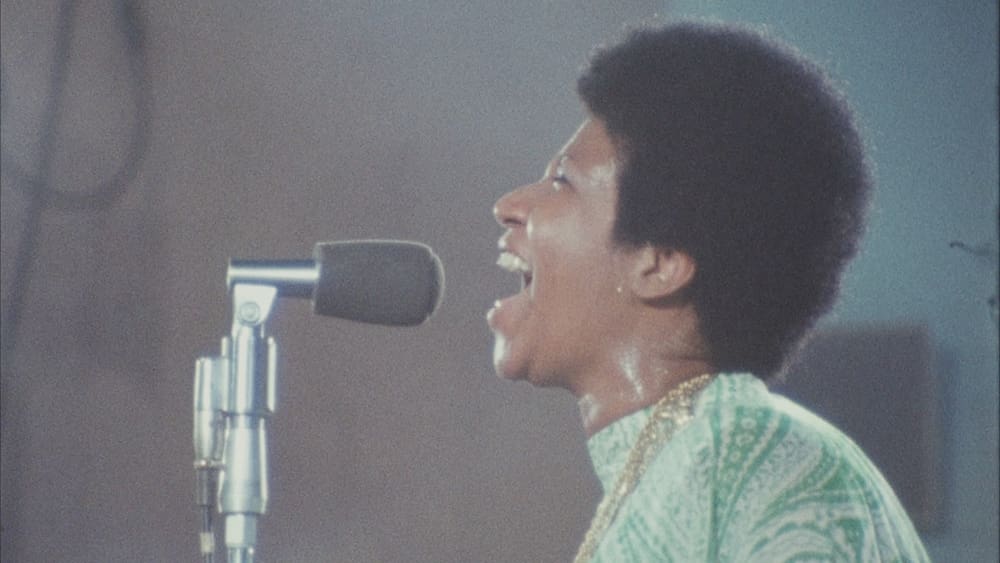
Aretha Franklin’s live gospel album, Amazing Grace, was a huge success when it was released on June 1, 1972. Recorded over two nights in January of that same year at the New Temple Missionary Church in Watts, California, the album features 14 tracks, including classics like the titular song and a modern mash-up of “Precious Lord, Take My Hand” and the Carole King-written, “You’ve Got a Friend.” While many have probably heard at least a track or two from the landmark album, most likely won’t know that at the time, Warner Brothers hired director Sydney Pollack to film the recording sessions for an eventual TV special.
Unfortunately, because the sound and images were filmed separately (as was standard at the time) and there were no time markers in the footage to give the production team direction, the film was never finished. Now, produced and “realized” by Atlantic Records staff producer, Alan Elliott, the film finally hits theaters as the new documentary, Amazing Grace. The result is just as spectacular as the album.
Elliott, who worked with the late Pollack and former Atlantic producer, Jerry Wexler, to put the film together, knows that the footage speaks for itself and after a few brief title cards to explain the context of the album’s production, he basically lets the two nights unfold as is with only a few songs elided. Because the film and audio Pollack’s crew took during the performances have been largely untouched and unused since they were recorded, the footage we see is in strikingly good condition. There are small moments where we see damage to the negative or hair in the gate, but most of the footage is clear and well-framed.
It also helps that Pollack and crew have the space staggeringly well-covered. We see shots of Franklin, Reverend Cleveland (who serves as both the spiritual and band leader) and the choir of course, but we see them from up close, from below, from behind, from above and from every other angle imaginable. We also see numerous shots of the crowd–both en masse and individually–reacting to Franklin’s performance and while a zoom of Mick Jagger sitting in the absolute worst seats in the house on Night Two are amusing, the true function of the crowd shots is the same as their presence on the album: to convey the energy and power of Franklin’s voice.
It’s fascinating to watch the energy in the room build as that first night of recording goes on and there’s a reason the film’s centerpiece is John Newton’s “Amazing Grace.” When it starts, the performance is stripped down and deeply traditional: Franklin simply stands in front of the mic, moved to sing each line by the Spirit regardless of what the band does. As they have for the rest of the show, the choir behind Franklin start seated, but as her singing becomes less restrained, more technically impressive, they begin to stand and yell in encouragement with each line. Soon, many are in tears and Reverend Cleveland has to stop playing the piano to weep. It’s impossible not to feel equally moved and it feels like a small mercy when the night ends there to give the audience time to recover.
Still, good as the “Amazing Grace” sequence is, the film is only half over by the time it ends and Night Two at first struggles to match it. Where Night One seemed to run smoothly, Night Two seems to start late and then has to stop again when the energy is just starting to build because a spilled glass of water knocks out Franklin’s mic. The mood stays subdued as her father, Reverend C. L. Franklin steps up to testify, but it’s during that speech that it becomes clear that Elliott doesn’t intend to close Night Two with the same energy as Night One.
As Reverend Franklin talks about how moved the audience clearly is by his daughter’s voice, he describes how moved he was when he began to notice and appreciate her gift in their home when she was a young girl. Though the remarks appear on the album as well, watching them delivered while thinking of young Aretha “synthesizing” the musical abilities she learned from her brother and heroes like Mahalia Jackson emphasizes how young Franklin is when the footage was filmed. She may have released 20 albums by then, but she’s still not beyond being embarrassed by her father‘s gushing.
As an exhausted Franklin and the choir launch into their final song, “Never Grow Old,” it’s impossible not to be struck by what a beautiful time capsule Amazing Grace really is. While it’s a shame the footage couldn’t have been released when and how it was originally intended, seeing it for the first time nearly half a century after its recording emphasizes what an extraordinary piece of history it is. The place Franklin sings of where those in the church will never grow old may be Heaven, but it’s also the film itself. Pollack, Franklin and undoubtedly many of the people who witnessed the two-day recording are up in Heaven and while we may not be up there rejoicing with them, we can watch them do so anyway, ageless, beautiful and truly divine.

